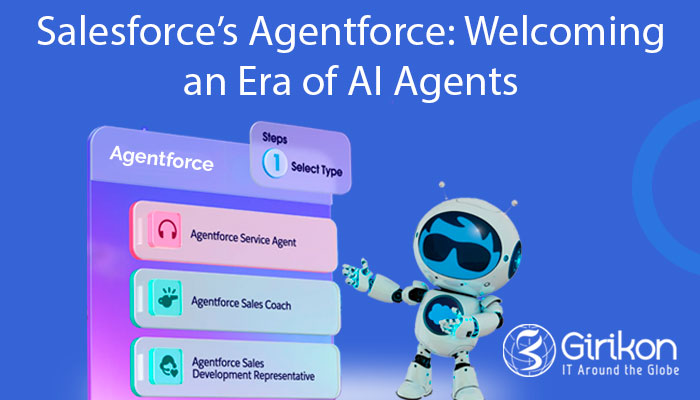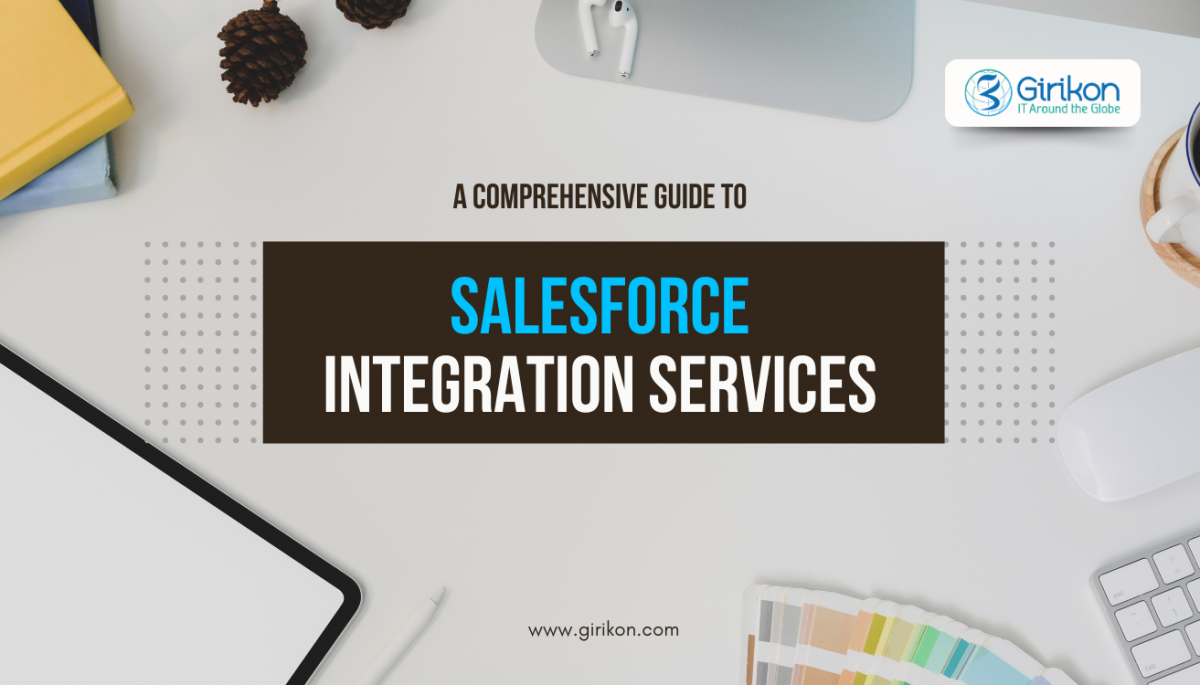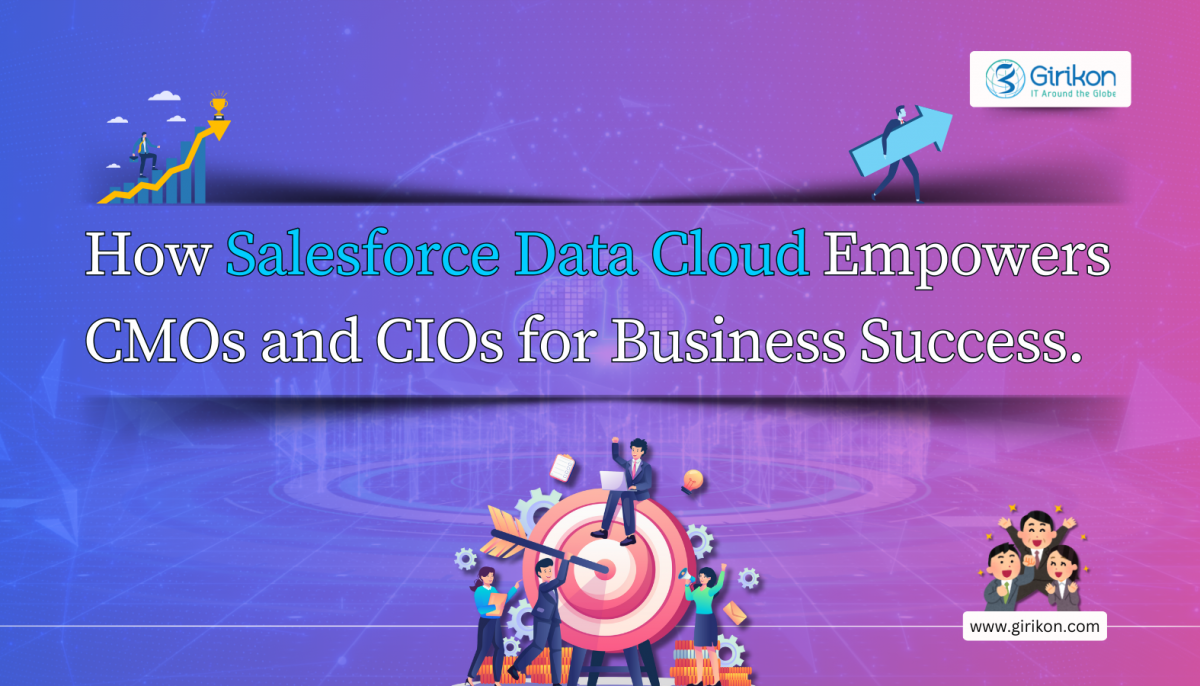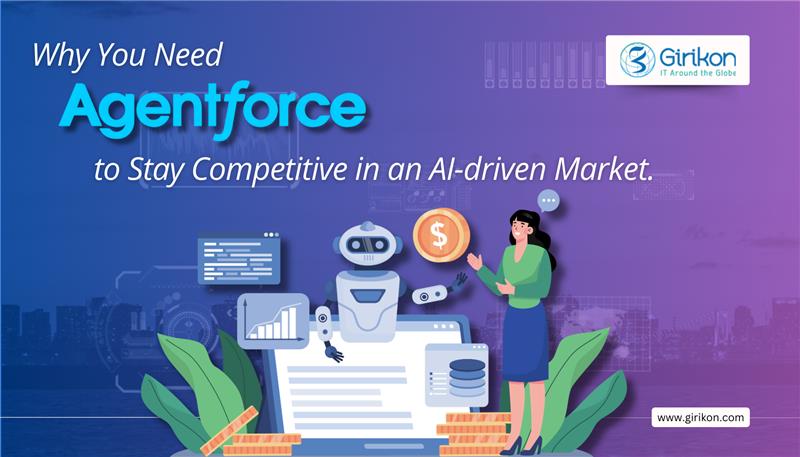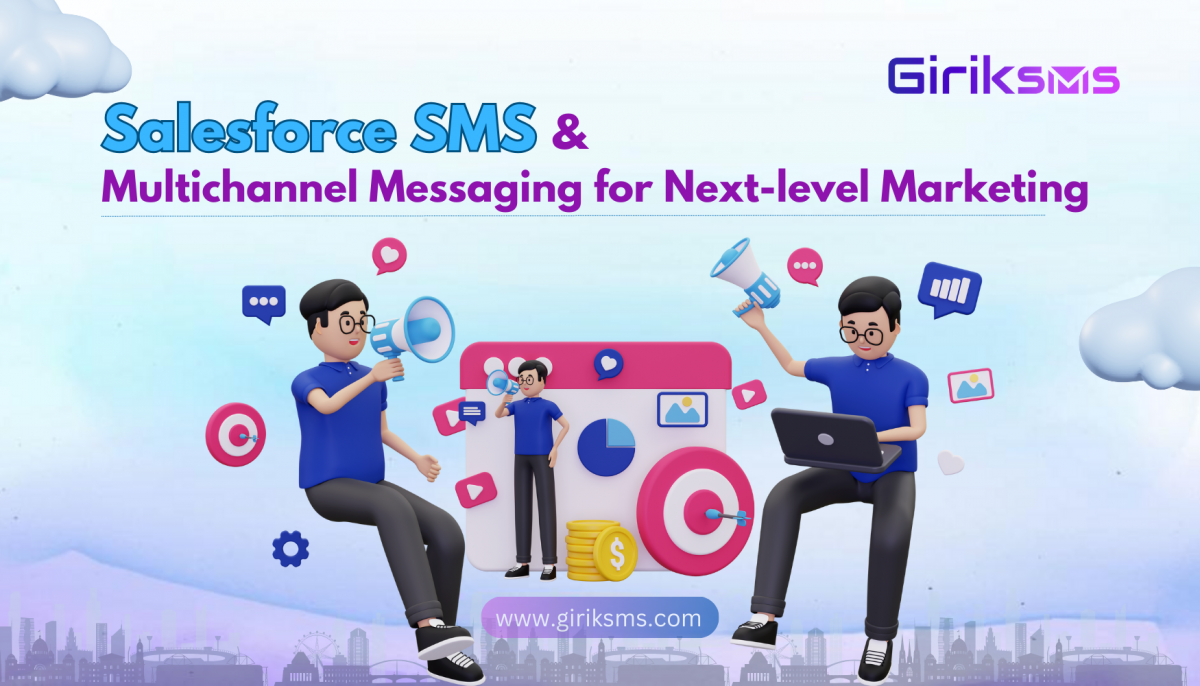AI has become an essential tool in transforming how we create, manage, and perceive digital content. Recently, we have witnessed its new face—which is more gigantic and vibrant.
Can you guess?
Agentforce—a discovery that amazed technology enthusiasts.
Unveiled by world’s #1 AI CRM, Agentforce is believed to transform how business interacts with customers. The tool represents “Third Wave of AI,” driving you to a digital era of highly accurate intelligent agents that ensure customer success.
With Agentforce, businesses can build and run their personal autonomous agents, thus handling tasks across the operation. Let’s explore and learn how Agentforce and its AI agents can bring a next evolution in customer service.
Introducing Agentforce: A Name, Worth the Hype
Humans with AI agents that analyze data, make decisions, and perform tasks, can scale their capabilities.
Agentforce is a groundbreaking suite of such agents!
It lets you create, customize, test, deploy, and manage your own agents quickly, with low-code tools. These agents are equipped with certain knowledge and data, letting them autonomously engage with customers, monitor workflows, and answer inquiries.
Driven by Data Cloud and Salesforce’s trusted architecture, these autonomous agents enhance interactions, ultimately elevating customer service.
The brain behind Agentforce agents is the Atlas Reasoning Engine. It is built to simulate humans’ actions to revert them naturally. It is only through this reasoning that users can equip agents with topics, which distinguish requests into a specific category, preparing them to take certain actions.
What is an AI Agent?
AI agents are autonomous intelligent systems, designed to conduct tasks without human intervention. These agents use Machine Learning to connect with the environment and accumulate data from Salesforce CRM data, data cloud, external data, etc. This allows them to comprehend customer inquiries and generate responses quickly.
Besides, these agents act and respond accurately much like human agents, and at the same time, automate complex workflows across all channels. For instance, they work on various platforms like messaging channels and self-service portals. Upon facing any complex problem, they handover the matter to human agents. This ensures faster resolution of issues, accelerating customer satisfaction.
Note: Getting the best Agentforce consulting services will let you learn more about these AI agents and their capabilities.
How to Build Agentforce’s Agents?
Till now, we have learned about the role of AI agents in automating complex or mundane tasks. But, one thing is still unanswered, how to build these autonomous agents? Let’s get the answer while taking insights from the Dreamforce’ 24 keynote.
1. Agent Description
To build your agent, you need to move to Agentforce Studio > Agent Builder.
Tap Configure Agent.
Add a Display Picture and provide the agent with a Name and Description.
Pick the channels like Email, Voice, Facebook, WhatsApp, etc. where you want humans and agents to communicate with each other.
Source – salesforceben.com
A glimpse of the interface below will help you understand these steps.
Note:
The left panel shows the AI agents setting page.
The right panel is to ask a question.
The middle panel, where we can evaluate the agent’s performance.
2. Agent Topics
Topics are the essential elements, determining the scope of work that agents can do. Simply put, it is a category of information, like an appointment management topic, letting the agent access appointment history data.
Look at the picture below, you’ll see the left-hand sidebar, clicking on it enables you to search for topics.
Source – salesforceben.com
You can also configure Topic under topic label, classification description, and scope. To give instructions, you need to tap the Instructions tab.
Source – salesforceben.com
3. Topic Actions
Now, you need to assign additional actions to your agents, which is as easy as ABC. Consider implementing these steps to do so:
Click on the Topic Actions.
This results in a new window titled Add Available Actions.
You will see a plethora of available actions, checkmark and choose the right actions.
Learn in this image about how the procedure will look like-
Source – salesforceben.com
So, these are some easy to perform steps, helping in building Agentforce’s agents. However, if you face any challenge with the procedure described, don’t hesitate to contact the Agentforce consulting company.
How do Agentforce’s AI Agents work?
You may be wondering about how these salesforce AI agents work. Don’t fret, we have summarized it here. Jump and explore how these agents learn, reason, and act autonomously.
1. Roles and Instructions
Each agent gets their defined roles and tasks at the very moment you assign them topics. They understand tasks using natural language instructions, making them adaptable to work.
2. Data Integration
Agents access the data located in Salesforce’s Data Cloud and Customer 360 platforms. This lets them get essential information, required to answer queries and make decisions in real time.
3. Actions
Besides, Agents are powered by Apex classes or predefined Flows, letting them take specific actions like resolving queries, scheduling appointments, and processing orders. You can configure these actions anytime, all thanks to the Salesforce’s in-built tools.
4. Guardrails
Some actions may not comply with company policies. So, to refrain agents from performing such responses, guardrails are implemented. These guardrails specify the boundary within, preventing agents from performing unauthorized actions.
5. Channels
Agentforce ensures seamless collaboration and interaction across multiple channels including
Marketing Cloud
Service Cloud
Sales Cloud
Commerce Cloud
WhatsApp
SMS
Apple Business Messenger
This is how it allows employees and customers to interact with autonomous agents.
Which Agent will You Create with Agentforce?
Agentforce with its tools like flows, prompts, Apex, and APIs, enables businesses to create and configure AI agents from scratch. Here are some agents that you can create while getting the best Agentforce consulting services.
1. Healthcare Agent
By Bridging the gap between patients, providers, and payers, these agents can autonomously build engagement, resolve cases and generate summaries across different channels.
2. Banking Agent
These agents scrutinize data to monitor client requests, and recommend personalized services across investment, commercial, and retail banking.
3. Retail Agent
Such agents answer queries for fashion, convenience, and grocery retailers. Besides, they proactively manage customer outreach and generate campaign insights.
4. Operation Agent
Operation agents autonomously guide operations team with resourcing needs, progress tracking, and plan creation.
5. Analytic Agent
Not just the agent shares data insights and visualizations, but also ensures that businesses take some essential decisions.
6. Finance Agent
Specialized in financial reporting and risk assessment, these agents focus on fraud detection and compliance solutions, promoting organizational transparency.
7. CX Agent
CX agents can be built to handle tasks like analyzing customer surveys and reviews, suggesting customer retention improvements, and managing omni-channel experiences.
8. IT Agent
From security threat detection to network insights generation, these IT agents can single-handedly do everything. Moreover, they can resolve customer and employee helpdesk support cases.
Key Features of Agentforce—Salesforce AI Agents
Now, let’s learn about some secret ingredients that make Agentforce—a competitive tool that ever existed.
1. Data Safety and Trust Layer
As Agentforce is built on Salesforce’s trusted infrastructure, you find no loopholes in its security and compliance. Even the Trust layer secures sensitive data and enforces strict privacy policy, thus ensuring security standards.
2. Easy Customization with No Code
Another thing that makes Agentforce a future-driven software is its no-code or low-code capability. It comes with Agent Builder-users upon accessing the same, can easily create, manage, and modify agents. They can eliminate leveraging deep technical expertise, thus enjoying customized agents, conducting their destined tasks.
3. Human-AI Collaboration
This collaboration has set the world on fire. By facilitating a smooth collaboration between human employees and AI agents, Agentforce enables companies to go beyond their limits. When agents take on essential tasks, employees can focus on the most challenging issues. This helps businesses deliver high-quality service.
4. Omnichannel Functionality
Agentforce is all about the omnipresence of AI agents. No matter at which channel you need, these agents can operate from anywhere. This ensures consistent and seamless interaction between businesses and customers through various platforms.
5. Customizable Actions
Salesforce tools like Flows and Apex enable users to create and customize actions for Agents. These actions can be anything from managing customer data, processing orders, to simple customer support.
The Future of Work in Collaboration with AI Agents
According to Kevin Quigley, Senior Manager at Wiley, Agentforce helps the company manage routine responsibilities, thus helping them save precious time, leading to a 40% increase in case resolution.
Paula Goldman, Salesforce’s Chief Ethical and Human Use office, also articulates that AI has brought a sea change for how we work today. From content creation to code generation, it has become our potential partner. And with Agentforce, it comes as an upgraded force, bringing limitless opportunities that make our jobs more fun and productive.
That’s not it, various claims have been made, showing how Agentforce’s capabilities can make a significant difference across customer touchpoints.
Indeed, listening to such things is music to all who are thinking of creating something great with AI agents. Are you the one? Don’t hesitate and move straight to company providing the best Agentforce consulting services.
Benefits of Having Salesforce AI Agents
Although you have a basic idea of all the benefits that Agentforce generates, ensure to read this section to explore more.
1. Enhanced Collaboration and Productivity
Handling repetitive or mundane tasks adds more to employees’ burden. However, when they have agents to perform the same, they can focus on high-value collaboration. Thus, driving better strategies to streamline productivity and workflow.
2. Cost Reduction
Agentforce enables business to deduct their operational costs. How? It automates labor-intensive work, cuts down on administrative tasks, and reduces the need to hire additional staff.
3. Consistency and Accuracy
With automated workflow, the likelihood of human errors gets minimized. Workers spend their time conducting their tasks, instead of correcting the mistakes. Thus, ensuring consistency and accuracy at all operational levels.
4. Improved Customer Experience
Agentforce’s agents work 24/7 providing personalized assistance and instant queries resolution in real-time. With such a service delivery, customers feel valued and keep coming back to businesses. Ultimately, it improves customer loyalty and experience.
Agentforce: Winning Hearts with the Union of Human + AI + Data + Actions
Now, let’s talk about the fusion that left the whole world in a state of awe.
1. Humans + AI
The use of AI as partners to humans can help maximize employees’ strength. How? AI agents can take on time-consuming jobs, saving time for employees to perform high-value tasks. What else? These agents can also escalate to humans when they get the task beyond their capacities.
2. Data
Every AI agent acts upon the data stored. They access the right data and use it across all sources to send emails, answer questions and book appointments. This escalates customer experiences and enhances business processes. Besides, Agentforce’s Data Cloud lets you create as many as intelligent agents, who are dynamic and possess a great knowledge of your operations.
3. Actions
An AI Agent without the ability to take measurable actions is just another bot. So, is it what makes Agentforce AI agents unique? Yes! You got it. Agentforce agents take action by exposing metadata of AI automation and defined workflow. In simple terms, they act by connecting data to actions like creating a close plan and drafting an email to a customer.
Use cases of Agentforce—Catering to Every Industry
Salesforce autonomous agents can cater to a wide range of needs across numerous industries such as
1. Sales
Upon acting as Sales Development Representatives (SDRs), these agents can:
Engage with prospects
Resolve their concerns
Manage objections
Schedule meetings
Thus, paving the way for more closed deals.
2. Inventory Management
Retail and supply chain operators can accompany autonomous agents for:
Monitoring stock levels
Automating reordering process
Sending notifications about low inventory
This helps them oversee inventory strength at any time anywhere.
3. Marketing Campaign
Marketing team can effortlessly manage their campaign with AI agents:
Suggesting optimization
Tracking engagement
Outlining campaign
4. Appointment Scheduling
Any industry that wants to skip the hassle associated with appointment scheduling can have the strength of AI agents to schedule, reschedule, and manage appointments.
Note: To look for real-life use cases, check how companies like Wiley, OpenTable, and Saks received impressive results with Agentforce.
Agentforce vs. Einstein Bots- Learn the Key Difference
Features
Agentforce
Einstein Bots
Use Case
Caters to various industry needs like marketing sales, commerce, customer service, etc.
Generates predefined answers for certain queries for the customer service industry.
Customization
Fully customizable, letting businesses create, tailor, and manage agents according to their specific preferences.
Limited customization capability with a basic bot-building interface.
Actions
You can add diverse actions, ranging from order processing to appointment scheduling.
You can provide actions only for support tickets handling and issue resolution.
Learning Capacity
Continuously learns and improves based on interaction and data received.
Restricted learning capability and improves when manual updates are done.
Data Handling
Accesses, stores, and analyzes real-time data from various sources, thus getting comprehensive insights.
Accesses only static and predefined data sets.
Whatever you want, Agentforce or Einstein Bots, Girikon—Salesforce implementation partner can help you integrate any of these within your existing system.
Agentforce Partner Network—World’s First Agent Ecosystem
Agentforce partner network consists of industry leaders like
Accenture, Capgemini, Deloitte Digital, IBM, PWC, Slalom, etc. These
experts are available on Salesforce AppExchange and ready to implement
and customize AI agents for you.
Even Salesforce implementation partners like Girikon are providing Agentforce consulting services. By leveraging their industry expertise, you can enjoy the creation of innovative Agentforce solutions for customers.
To tap into an ecosystem of accelerated processes and opportunities, connect with our renowned consultants at Girikon.
Conclusion!
The challenges businesses face today highlight the need to switch to automated tools and agents.
With the arrival of Agentforce– a transformative ally, businesses
not only streamline operations but also create meaningful interactions
with customers.
This is totally exciting in a world where customer loyalty is hard
won. Want to embrace solutions like Agentforce? Get in touch with
Girikon, an Agentforce consulting company and enable your enterprise to
sail smoothly through the turbulent water of competition.
FAQs
1. What are some Agentforce’s Pre-built Agents?
Agentforce does not only let us create and customize AI agents from scratch, but it also provides some pre-built agents, simplifying businesses’ needs & tasks.
Service Agent: Engages with customers 24/7 in natural language.
Sales Development Representative (SDR) Agent: Resolves product-related queries and books meetings for sales representatives.
Sales Coach Agent: Handles objections, provides feedback, and shares areas for improvement.
Personal Shopper Agent: Connects with shoppers on your commerce site or in a messaging app.
Campaign Agent: Generates a campaign brief, content, target audience segment, etc.
2. What is the Secret Recipe Behind Agentforce?
Features like data safety with trust layer, easy customization with no code, human-AI collaboration, omnichannel functionality, customizable actions, etc., are the real secret behind Agentforce’s gigantic capabilities.
3. How much does Agentforce AI Agents Cost?
$2 per conversation
The pricing model of Agentforce is based on “per conversation.” $2 is the starting price with discounts available for enterprises dealing with higher volumes.
4. When will Salesforce Agentforce Available?
Agentforce for Service and Sales will launch on October 25, 2024. However, its advanced features like Atlas Reason Engine will be available for use from February 2025.
.blog-faq-section .faqhead{ background-color: #0e71b6; padding: 5px; font-size: 24px; line-height: 32px; color: #fff; margin: 10px 0px 10px 0px; font-weight: 600;}
.blog-faq-section .panel-group .panel-default > .panel-heading {background-color: transparent !important;}
.blog-faq-section .panel-group .panel-default .panel-heading .panel-title a {color: #000 !important; font-size: 18px;}
h1{ color: #0e71b6 !important;}
h3{/*background-color: #3598DB;*/ padding: 5px; font-size: 24px; line-height: 32px; color: #0e71b6; margin: 10px 0px 10px 0px;border-bottom: 2px solid #0e71b6; font-weight: 600;}
p{ padding: 0px 0px 15px 10px; margin: 0px;}
ul{margin: 0px 0px 0px -15px;}
.customtable-single-blog{ margin: 0px 0px 30px 0px;}
.customtable-single-blog table tbody tr th{background-color: #c7e8ff; color: #000; font-weight: 700;font-size: 18px; line-height: 24px; text-align: left; padding: 10px; border: 1px solid #000;}
.customtable-single-blog table tbody tr td{ color: #000; font-weight: 400;font-size: 16px; line-height: 22px; text-align: left; padding: 10px; border: 0px; border: 1px solid #000;}
.customtable-single-blog table tbody tr td:first-child{ font-weight: 700;}
function openCity3(evt, cityName3) {
var i, tabcontent3, tablinks3;
tabcontent3 = document.getElementsByClassName("tabcontent3");
for (i = 0; i < tabcontent3.length; i++) {
tabcontent3[i].style.display = "none";
}
tablinks3 = document.getElementsByClassName("tablinks3");
for (i = 0; i < tablinks3.length; i++) {
tablinks3[i].className = tablinks3[i].className.replace(" active", "");
}
document.getElementById(cityName3).style.display = "block";
evt.currentTarget.className += " active";
}
// Get the element with id="defaultOpen" and click on it
document.getElementById("defaultOpen3").click();
var accdn = document.getElementsByClassName("accordion");
var i;
for (i = 0; i < accdn.length; i++) {
accdn[i].addEventListener("click", function() {
this.classList.toggle("active");
var content = this.nextElementSibling;
if (content.style.display === "block") {
content.style.display = "none";
} else {
content.style.display = "block";
}
});
}
var accdn = document.getElementsByClassName("acc");
var i;
for (i = 0; i < accdn.length; i++) {
accdn[i].addEventListener("click", function() {
this.classList.toggle("active");
var content = this.nextElementSibling;
if (content.style.display === "block") {
content.style.display = "none";
} else {
content.style.display = "block";
}
});
}

 +1-480-382-1320
+1-480-382-1320 +44-7428758945
+44-7428758945 +61-1300-332-888
+61-1300-332-888 +91 9811400594
+91 9811400594


